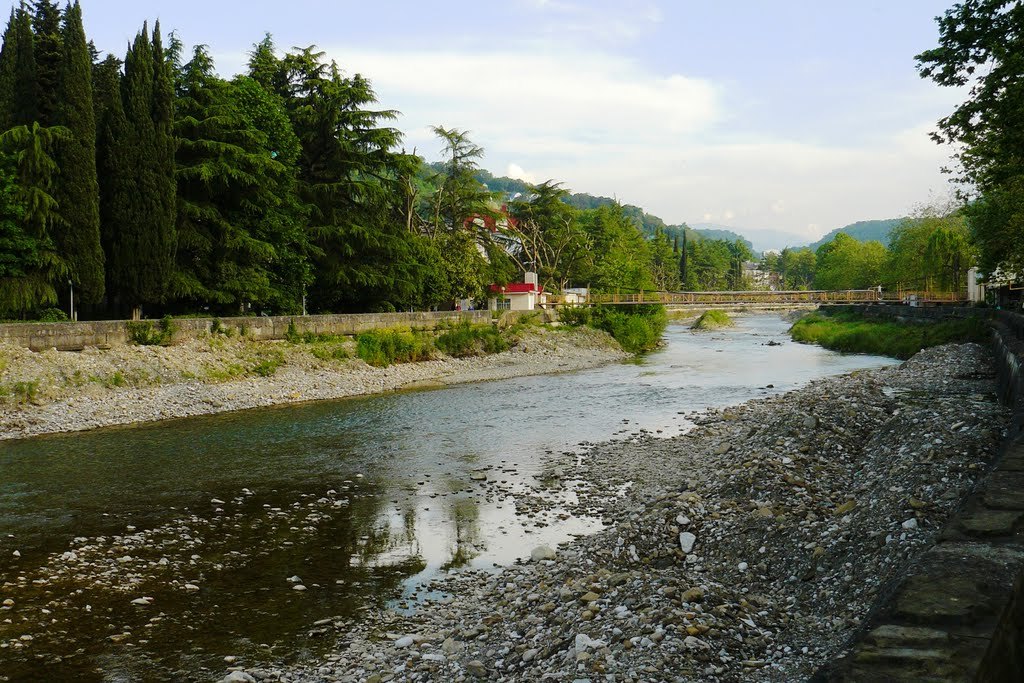Khostinsky district is one of the four areas of the resort of Sochi. It is located approximately in its middle. It is suitable for beach vacations, treatments and nature excursions. It is located between the Kudepsta River and the Vereshchaginsky Valley. The Khosta River (Sochi) is the main river of the district.
Geographical features of the Khostinsky district
Khostinsky district is located in the foothills of the southern slope of the Main Caucasus Range. In the south, it borders the sea, and in the north, with the mountains of the Sochi National Park. It is a hilly area, covered with forests and farmland. The climate is humid, marine. Autumn and winter are rainy, and summers are relatively dry and moderately hot. In Khost it is slightly hotter and drier than in Sochi. The number of sunny days in this city is as much as 280. This is more than in other points in the resort of Sochi.
The amount of precipitation increases when moving from the sea towards the mountains. Global warming makes Sochi summer more and more stuffy.
The nature of the area
Broad-leaved forests grow on the hills and river valleys: oak, hornbeam, beech, chestnut, etc. In some places yew trees are found. Until recently, the district was famous for the famous Tisosamshit grove, but in just a couple of years boxwood was destroyed by a dangerous parasite - box fire. In the future there is a chance for its restoration due to the resettlement of plants resistant to this parasite, which were found in single copies in the Caucasian reserve.
Rest in the Khostinsky district of Sochi
The Khostinsky district is more suitable for a quiet measured rest than the city of Sochi. It is not so noisy and not so dense buildings. More greenery and free space on the beaches. True, all this with reservations, since in recent years the entire coastal strip of Sochi has been actively built up, and there have been many more people.
The host is ideal for a beach and medical holiday. The balneological segment is especially developed here, for which there is all the necessary infrastructure. There are good places for excursions. For example, Khostinsky Tisosamshitovaya grove (now without boxwood) and Agursky waterfalls. On the rivers Matsesta and Khosta there are sources of mineral waters. On their basis balneological sanatoriums are created. There is a branch of the Institute of balneology and physiotherapy in the Khostinsky district.
In addition to a spa holiday, the area is well suited for spending holidays with family. Of the interesting sights, Mount Akhun, on top of which there is an observation tower, has become most famous. You can also visit the Vorontsov caves, Eagle Rocks, Kalinovoe Lake. In Matsesta there are sources of hydrogen sulfide.
Khosta River
This river flows exactly in the middle between the cities of Sochi and Adler. The name of the Khosta River is of Caucasian origin and translates as “Boar River”. Probably, there were many wild boars there before. It originates from the wooded ridges of the southern macro slope of the Greater Caucasus, covered with virgin and dense mountain-colchis forests of the Sochi National Park. Further, it flows through a hilly valley with broad-leaved forests, in which there are relict species, for example, yew. The tops of the hills are used for agriculture. In its lower reaches, it flows past the Tisosamshit grove and after a couple of kilometers it flows into the Black Sea.

If you move up the Khosta River, then beyond the Tisosamshitovaya grove it is divided into two similar rivers - Mal. Hosta and Bol. Hosta, which form two similar wooded valleys, and the distance between these rivers is about 2 km. The length of the channel of the united river with the name "Hosta" is 4.5 km, and from the origins of the Big Hosta - 21.5 km. The area of the river basin is 96.2 square meters. km The tortuosity is expressed relatively weakly (coefficient 1.03).
Near the river there are dolmens. Not far from the estuary, the federal highway and the railway cross the Hosta.